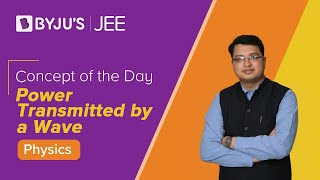When a wave travels through a medium, it will transmit energy to the medium. This can be directly observed sometimes. A few examples of energy carried by the wave are as follows: waves during earthquakes shake the entire city, loud noises can damage the hearing of a person, ultrasound waves are used in the deep heat treatment for muscle strains, etc. The rate of flow of energy is the power transmitted by the wave.
Energy in Wave
The energy associated with a wave is given in terms of its amplitude and frequency. If the earthquake is of larger amplitude, then the displacement will be more. The energy of the wave in a stretched string is expressed as the energy per wavelength. The total energy of the string is equal to the sum of the potential energy and kinetic energy.

Let us consider a small element of the string. The differential form of the elastic potential energy is
dU = (½) ω2y2dm = (½) ω2y2μdx
The travelling wave is given by the expression, y = Asin(kx – ωt)
The potential energy becomes
dU = (½) ω2[Asin(kx – ωt)]2μdx
= (½)μω2A2sin2(kx – ωt)dx
The energy of the entire wavelength can be determined by integrating the above expression. For convenience, time is set as t = 0
The differential form of kinetic energy is
dKE = (½)vy2dm = (½)vy2μdx
Using the velocity expression,
vy = ωAcos(kx – ωt)
The kinetic energy becomes
dKE = (½)vy2dm = (½)[ωAcos(kx – ωt)]2μdm
= (½)μω2A2cos2(kx – ωt)dx
Integrating the expression and taking t = 0, we get
The total energy associated with a wavelength is
E = Uλ + KEλ
= (½)μω2A2λ
This amount of energy gets transmitted through a distance of one wavelength along the string in one time period.
Power Transmitted by a Wave
For a sinusoidal wave, the power of the wave is the rate of flow of energy, i.e., the energy divided by the period of the wave.
Power = E/T = (½)μω2A2(λ/T)
= (½)μω2A2(λ/T)
The wavelength divided by the time period is the velocity of the wave(v)
P = (½)μω2A2v
The angular frequency ω can be written as 2πf
Therefore, P = 2π2A2f2μv
So, the power transmitted by the wave is equal to the square of the frequency and amplitude.
Intensity of a Wave
The other important characteristic of the wave is intensity. The waves can spread out over a larger area or concentrate at a point. The earthquake wave will be less damaging if it is spread out in a larger area. The area the waves cover has important effects. Intensity is defined as the power per unit area.
I = P/A
Here, P is the power, and A is the area.
The SI unit of intensity is given as watts per square metre (W/m2).
Solved Examples
1. A wave of frequency 200 Hz and amplitude 1 mm travels along a long string with a linear mass density of 6 g/m kept under a tension of 60 N. (a) Find the average power transmitted across a given point on a string. (b) Find the total energy associated with the wave in a 2.0 m long portion in the string.
Solution:
(a) To calculate the average power
Given
f = 200 Hz
A = 1mm = 10-3 m
T = 60 N
μ = 6 g/m = 0.006 kg/m
Velocity = √T/μ
= √60/0.006
= 100 m/s
Average Power, P = 2π2A2f2μv
P = 2 x (3.14)2 x 10-6 x (200)2 x (0.006) x 100
P = 0.47 W
(b) To calculate the energy
Length of the string, x = 2m
Time t = x/v
= 2/100
= 0.02 sec
Energy = Power x time
= 0.47 W x 0.02 sec
= 9.4 x 10-3 J
Related Video

Frequently Asked Questions on Power Transmitted by a Wave
What is the power transmitted by a wave?
A sinusoidal wave’s time-averaged power is proportional to the square of the wave’s amplitude and the square of the wave’s angular frequency. The power would increase by a factor of four if either the angular frequency or the amplitude of the wave were doubled.
What is the relation between power and wavelength?
The quantity of energy in a photon is directly proportional to its electromagnetic frequency and, consequently, inversely proportional to its wavelength.
Does the frequency affect the power of the wave?
The power of the wave is directly proportional to the frequency.
Comments